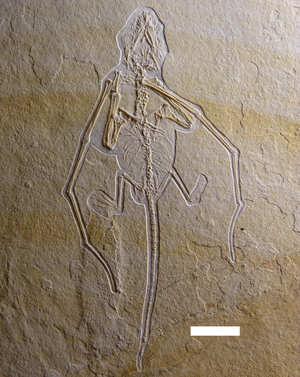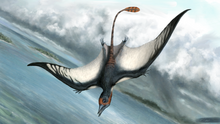Bellubrunnus
| Bellubrunnus | ||||||||||||
|---|---|---|---|---|---|---|---|---|---|---|---|---|

Holotype of bellubrunnus (scale bar equals 1 cm) |
||||||||||||
| Temporal occurrence | ||||||||||||
| Upper Jurassic ( Kimmeridgian ) | ||||||||||||
| 152.1 million years | ||||||||||||
| Locations | ||||||||||||
| Systematics | ||||||||||||
|
||||||||||||
| Scientific name | ||||||||||||
| Bellubrunnus | ||||||||||||
| Hone et al. , 2012 | ||||||||||||
| Art | ||||||||||||
|
||||||||||||
Bellubrunnus ( "Beautiful Brunner") is a genus of Flugsaurier (Pterosauria) from the upper Jura Central Europe . Their only species , Bellubrunnus rothgaengeri , was a small member of the Rhamphorhynchidae , which was characterized by curved wing bones, a long tail and short, toothed jaws. The genus is known from a single fossil , an almost completely preserved young animal that was found in the Brunner Plattenkalken in southern Germany . Bellubrunnus lived in a tropical archipelago near the coast during its lifetimeand possibly ate fish.
The remains of the genus found in 2002 were first described in 2012 . They resemble those of the late Jurassic Rhamphorhynchus , with which Bellubrunnus was probably closely related. The temporal and spatial proximity of both genera allows the conclusion that they are sister taxa or that Bellubrunnus was a forerunner of Rhamphorhynchus .
features

Bellubrunnus was a typical rhamphorhynchid with a long tail and a relatively short metacarpal . He had toothed jaws and was characterized by curved fourth wing finger phalanx. Since no fully grown specimens have been found so far, only the early shape of the animals can be inferred. Bellubrunnus juveniles had short, more triangular skulls with relatively very large eyes, as can be deduced from the dimensions of the scleral rings . They had 20–22 teeth in the mouth, but it is unclear how they were spatially distributed. The teeth were pointed and straight and thus differed somewhat from the backward curved teeth of Rhamphorhynchus . The holotype's wing finger is 93 mm long, its humerus 14 mm. The tail of Bellubrunnus had only very short pre- and postzygapophyses and chevron bones . In its basic morphology , the genus showed clear similarities to Rhamphorhynchus , but differed from this mainly in the caudal vertebrae, the curved wing bones and the weaker dentition.
Site, fossil material and stratigraphy
The only specimen of Bellubrunnus comes from a quarry near Brunn in Bavaria , where Monika Rothgänger found it in 2002 during private excavations. It is an almost complete, largely articulated and preserved skeleton of a young animal ( inventory number BSP –1993 – XVIII – 2), which is now in the Solnhofen Mayor-Müller Museum . Its find layer, the Brunner Plattenkalke, is dated to the late Kimmeridgian (152.1 mya ). It falls into the Subeumela subzone ( Beckeri zone), as can be seen from the fossil ammonite fauna . The limestone sediments deposited there come from a lagoon that was part of the Jurassic archipelago in what is now southern Germany.
ecology
The Brunner ecosystem is distinguished from the somewhat younger Solnhofen layers by reefs and bio-thermal baths . Like the former Solnhofen archipelago, they were characterized by a warm climate. So far, mainly remains of fish have been uncovered in the Brunner deposit; besides Bellubrunnus , a young turtle and four sphenodontic animals are the only terrestrial vertebrates found . The curved wing tips of Bellubrunnus indicate that the animals were agile fliers.
Systematics and taxonomy
The specimen found by Rothgänger was first described as a new genus and species in 2012 by David Hone , Helmut Tischlinger , Eberhard Frey and Martin Röper . They named the new taxon Bellubrunnus rothgaengeri . The generic name means something like "Beautiful Brunner" and refers to the place where it was found, the specific epithet honors Monika Rothgänger for her research into the place of discovery over many years. Based on the general morphology, Hone and colleagues classified the fossil as a representative of the Rhamphorhynchidae , a group of pterosaurs that first appeared in the Toarcian and became extinct towards the end of the Tithonian . Bellubrunnus shows similarities within the Rhamphorhynchidae especially with Rhamphorhynchus , who lived in the Tithonium in the same region. Although the authors did not perform a phylogenetic analysis, they did emphasize the possibility that Bellubrunnus and Rhamphorhynchus could be sister taxa . Since both genera have not yet been found sympatric , Bellubrunnus could also be the direct ancestor of the genus Rhamphorhynchus .
swell
literature
- David WE Hone, Helmut Tischlinger, Eberhard Frey, Martin Röper: A New Non-Pterodactyloid Pterosaur from the Late Jurassic of Southern Germany. In: PLoS ONE . Vol. 7, No. 7, 2012, e39312, doi : 10.1371 / journal.pone.0039312 .
